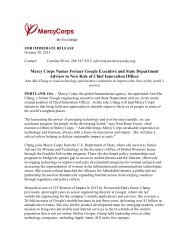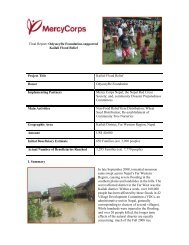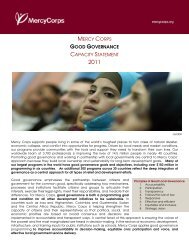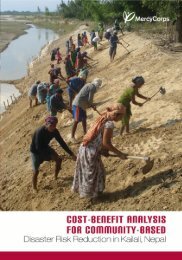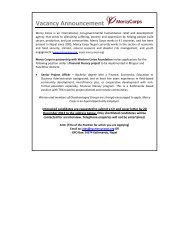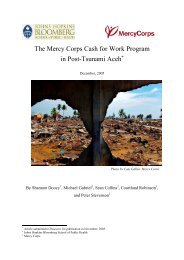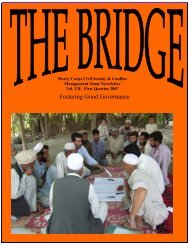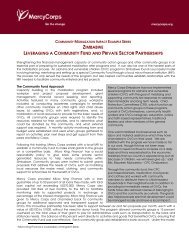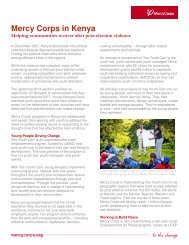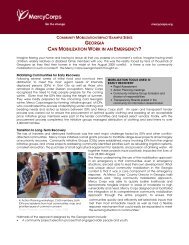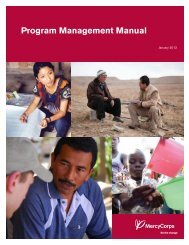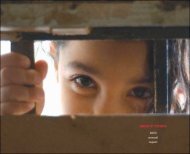Disaster Risk Reduction at Mercy Corps
Disaster Risk Reduction at Mercy Corps
Disaster Risk Reduction at Mercy Corps
- TAGS
- reduction
- corps
- www.yumpu.com
Create successful ePaper yourself
Turn your PDF publications into a flip-book with our unique Google optimized e-Paper software.
<strong>Disaster</strong> <strong>Risk</strong> <strong>Reduction</strong> is essential to <strong>Mercy</strong> <strong>Corps</strong>’mission to build secure, productive and just communities.Wh<strong>at</strong> is DRR?For NGOs, <strong>Disaster</strong> <strong>Risk</strong> <strong>Reduction</strong> (DRR) is the system<strong>at</strong>ic development andapplic<strong>at</strong>ion of policies, str<strong>at</strong>egies and practices designed to minimize the vulnerability ofcommunities to the risks of disasters. DRR activities prepare communities and minimizethe adverse effects of hazards within the context of sustainable development and goodgovernance.Wh<strong>at</strong> principles guide <strong>Mercy</strong> <strong>Corps</strong> DRR str<strong>at</strong>egy?We focus our efforts to reduce disaster risks on three levels — <strong>at</strong> local communities, <strong>at</strong>n<strong>at</strong>ional and intern<strong>at</strong>ional DRR policy, and <strong>at</strong> programming within our own agency.A. Strengthening communitiesWe incorpor<strong>at</strong>e DRR in our work to help communities become more resilientto hazards and less likely to have their progress undermined by a disaster. Thisincludes analysing the impact of clim<strong>at</strong>e change and minimizing its compoundingeffects on current hazards through appropri<strong>at</strong>e adapt<strong>at</strong>ion str<strong>at</strong>egies.• We engage communities and local partners to increase their own resilienceMeaningful and inclusive particip<strong>at</strong>ion in DRR assessments, planning and decisionmaking <strong>at</strong> the household, community, and local government levels is crucial toempower communities to ‘own’ their solutions and to identify and protect theirmost vulnerable members (e.g., children, people with disabilities).• We use a multi-hazard approach (including considering clim<strong>at</strong>e change)Communities reduce more risk and benefit most by preparing for several hazardsthey are likely to face (r<strong>at</strong>her than just one). Often prepar<strong>at</strong>ions are similarfor different hazards. Before DRR programs are implemented, the communityassesses its situ<strong>at</strong>ion by completing a hazard, vulnerability, and capacityassessment (HVCA) which includes risk analysis and planning.• We aim to strengthen local DRR capacitiesLocal needs and priorities are the starting point for strengthening communitiesand their institutions. We strive to increase community’s capacities to leadrisk assessments (e.g., local hazard mapping, HVCAs), local action planning,preparedness activities (e.g., community-wide disaster drills), and to developbudgets and proposals.B. We advoc<strong>at</strong>e DRR-supportive policies and funding to multil<strong>at</strong>eraland bil<strong>at</strong>eral donorsChange <strong>at</strong> the community level will not be sustainable without supportingadjustments <strong>at</strong> the n<strong>at</strong>ional and intern<strong>at</strong>ional levels. The Hyogo Framework forFlood Evacu<strong>at</strong>ion bridge in Tajikistan.Action 1 is the intern<strong>at</strong>ional pl<strong>at</strong>form for DRR and we organize our work to achievethe HFA’s 5 priorities:1. Ensure th<strong>at</strong> DRR is a n<strong>at</strong>ional priority2. Identify, assess and monitor disaster risks and enhance early warning systems3. Build a culture of safety and resilience by using knowledge, innov<strong>at</strong>ion and educ<strong>at</strong>ion4. Reduce underlying risk factors5. Strengthen disaster preparednessC. We advance our DRR agenda by integr<strong>at</strong>ing a DRR perspective into existing programsOur goal is to integr<strong>at</strong>e DRR in all our programming, but especially in areas with ahigh hazard risk.• We respond to n<strong>at</strong>ural hazards and complex emergencies by ‘building backbetter’ and adapting to clim<strong>at</strong>e change risks to cre<strong>at</strong>e more resilient communities.In programs after the earthquake in Haiti, participants cleaned rubble anddrainage canals to prevent flooding during hurricanes.• In countries experiencing economic transition, we aim to build economicresilience by protecting livelihoods and diversifying the economy. In Georgia, ourwork developing the me<strong>at</strong> and dairy market includes emergency plans for floodingand forest fires.• In conflict-afflicted countries, we use DRR to bring groups togetherand we try to ensure th<strong>at</strong> n<strong>at</strong>ural hazards do not intensify differences. In Ethiopia,farmers are more resistant to drought AND conflict through veterinary care andaccess to we<strong>at</strong>her-rel<strong>at</strong>ed inform<strong>at</strong>ion.1 The Hyogo Framework for Action (HFA) is a ten-year action framework, 2005-2015. An agreement reachedby 168 member st<strong>at</strong>es after the World Conference on <strong>Disaster</strong> <strong>Reduction</strong> in Kobe (January 2005), it aims tosubstantially reduce the loss of life as well as the social, economic and environmental losses suffered by communitiesand n<strong>at</strong>ions as a result of disasters. UN-ISDR implements the HFA agenda.Constructing a bamboo spur toreduce the impacts of flooding.Case StudySonu Ram Chaudhary, memberof the disaster preparednesscommittee in Bishanpur knowsthe Mohana River like the backof his hand. He’s been swimmingand fishing along its banks for thelast 40 years and not all his memories are positive. The river has changed its course morethan 4/10s of a mile and cut off more than 86 acres of productive land while floodingcommunities and eroding riverbanks.During the monsoon season, heavy rainfall upstream triggers flash floods fordownstream communities. The floodw<strong>at</strong>er carries huge amounts of sediment causing theriverbed to rise, undercutting one bank and depositing sediment on the other. The situ<strong>at</strong>ionis further aggrav<strong>at</strong>ed by back w<strong>at</strong>er when tributaries meet the bigger Mohana River in thesouth because there are stable and confined banks on the India side of the river.Before the bio-engineering DRR project, Sonu Ram, said: “We have tried everythingfrom constructing raised embankments parallel to the river flow to planting besarmi plantsalong the bank, and nothing has worked. Soon, we will be history.”But to solve these problem, bamboo walls were built to protect the sloping riverbanks,and trees and shrubs were planted on the banks and nearby land. This protected andstabilized the riverbanks by preventing erosion and reducing shallow landslides. The typeof veget<strong>at</strong>ion planted was carefully selected to c<strong>at</strong>ch debris, reinforce the soil, anchorthe surface layer, support the slope and facilit<strong>at</strong>e drainage. The bamboo structures arestrong <strong>at</strong> the beginning and as their strength gradually decreases, the plants and their rootstructures are get stronger.After the monsoon season Sonu Ram said: “This year’s flood was the biggest in 30years and where we did the bio-engineering work we didn’t lose any land to river erosion.We are impressed and plan to continue this work.” Bishanpur has now replic<strong>at</strong>ed more than550 meters of bank protection and are planning for 200 meters more this year.DISASTER RISK REDUCTIONSupporting Communities/Building ResilienceFor more inform<strong>at</strong>ion contact:DRR@mercycorps.orgCover: Nepal — Miguel Samper for <strong>Mercy</strong> <strong>Corps</strong>; Inside: Tajikistan — Jason Sangster for <strong>Mercy</strong> <strong>Corps</strong>; Poster, from top Left to Right: Nepal — Miguel Samper for <strong>Mercy</strong> <strong>Corps</strong>,Pakistan — Julie Denesha for <strong>Mercy</strong> <strong>Corps</strong>, Haiti — Miguel Samper for <strong>Mercy</strong> <strong>Corps</strong>, Tajikistan — John Strickland/<strong>Mercy</strong> <strong>Corps</strong>; Backcover: Nepal — <strong>Mercy</strong> <strong>Corps</strong>0811



